Physical Address
304 North Cardinal St.
Dorchester Center, MA 02124
Plasma cell disorders are neoplastic or potentially neoplastic diseases associated with the clonal proliferation of immunoglobulin-secreting plasma cells ( Table 173-1 ). These disorders are characterized by the secretion of electrophoretically and immunologically homogeneous (monoclonal) proteins that represent intact or incomplete immunoglobulin molecules. Monoclonal proteins are commonly referred to as M proteins, myeloma proteins, or paraproteins.
|
Syndromes associated with plasma cell disorders and monoclonal proteins include premalignant disorders (monoclonal gammopathy of undetermined significance; MGUS), smoldering multiple myeloma, malignant neoplasms (multiple myeloma, Waldenström macroglobulinemia), as well as disorders primarily related to the unique properties of the secreted monoclonal protein (cryoglobulinemia, immunoglobulin light chain [AL] amyloidosis, light chain deposition disease; see Table 173-1 ).
Intact immunoglobulins consist of two heavy (H) polypeptide chains of the same class and subclass and two light (L) polypeptide chains of the same type ( Chapter 35 ). The heavy polypeptide chains are designated by Greek letters: γ in immunoglobulin G (IgG), α in immunoglobulin A (IgA), µ in immunoglobulin M (IgM), δ in immunoglobulin D (IgD), and ε in immunoglobulin E (IgE). The light chain types are kappa (κ) and lambda (λ). Both heavy chains and light chains have “constant” and “variable” regions with respect to the amino acid sequence. The class specificity of each immunoglobulin is defined by a series of antigenic determinants on the constant regions of the heavy chains (γ, α, µ, δ, and ε) and the two major classes of light chains (κ and λ). The amino acid sequence in the variable regions of the immunoglobulin molecule corresponds to the active antigen-combining site of the antibody.
In the majority of clonal plasma cell disorders, intact immunoglobulin molecules are secreted as monoclonal (M) proteins. In addition, there can also be abnormal secretion of excess monoclonal free light chains (FLCs) that are released without being bound to immunoglobulin heavy chains. In some patients, heavy chain expression is completely lost, and only monoclonal free light chains (commonly referred to as Bence Jones proteins) are secreted. Even less frequently, only heavy chains are secreted, resulting in heavy chain diseases (HCDs). Rare patients with multiple myeloma secrete no identifiable immunoglobulin (“nonsecretory myeloma”).
Protein electrophoresis of the serum and urine detects M protein as a narrow peak (like a church spire) on the densitometer tracing or as a dense, discrete band on agarose gel ( Fig. 173-1 ). Electrophoresis also permits quantitation of M proteins. Monoclonal light chains (Bence Jones proteins) are rarely seen on serum electrophoresis but are easily detected on urine electrophoresis. Urine electrophoresis requires a 24-hour urine collection.
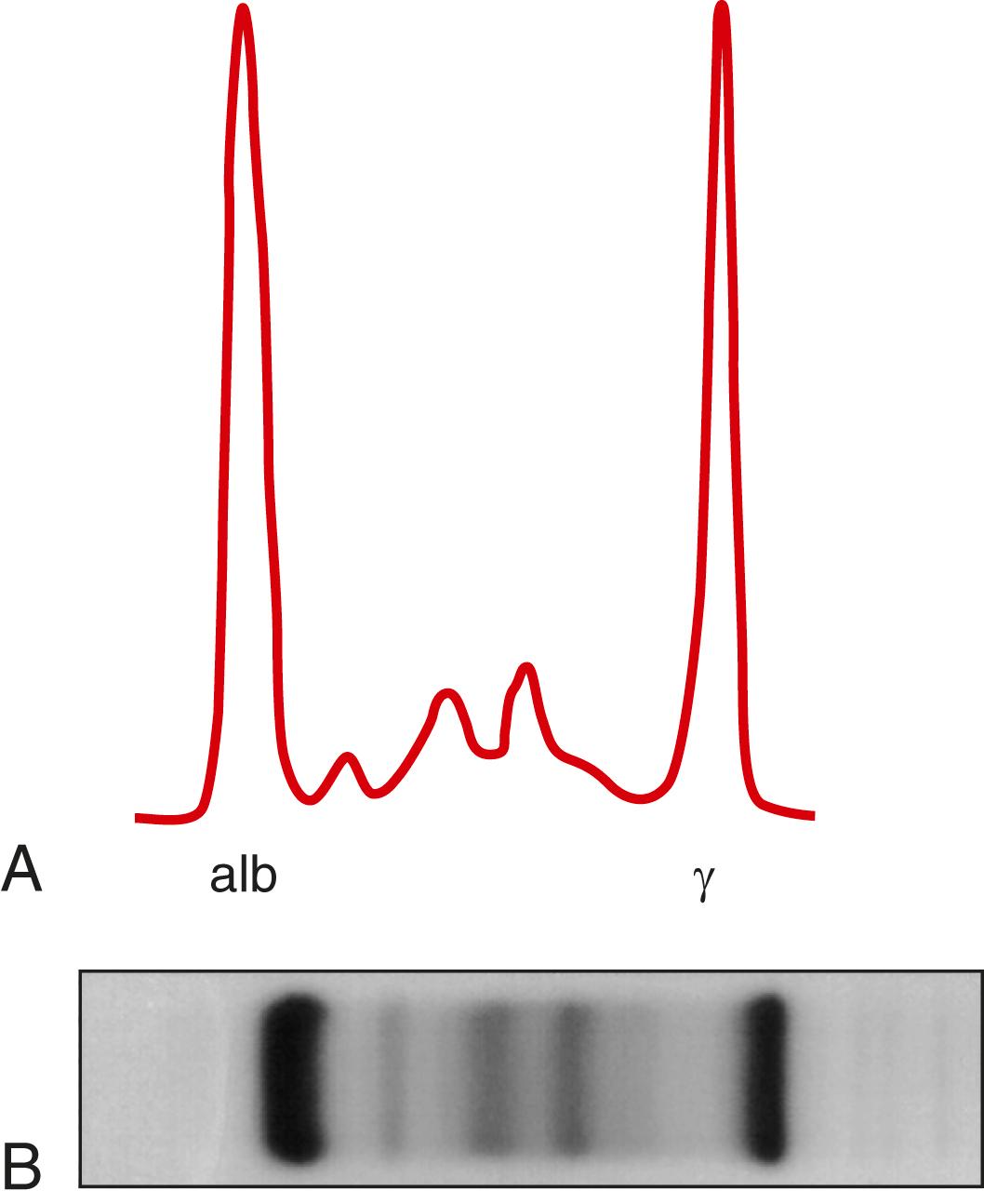
When a peak or band is first seen on protein electrophoresis, immunofixation of the serum and urine should be performed to identify the heavy and light chain type of the M protein. Immunofixation is also a more sensitive test than protein electrophoresis, and it should always be performed in conjunction with electrophoresis when multiple myeloma or related disorders are first suspected so as to detect small, unmeasurable M proteins that may be missed on electrophoresis. Immunofixation is particularly important in oligosecretory myeloma, primary amyloidosis, and solitary plasmacytoma, as well as after successful treatment of multiple myeloma or macroglobulinemia. In these instances, a small M protein can be concealed within the normal β or γ areas of the electrophoresis gel and may be overlooked. Mass spectrometry can be used instead of immunofixation to identify the M protein more accurately ( E-Figs. 173-1 and 173-2 ).
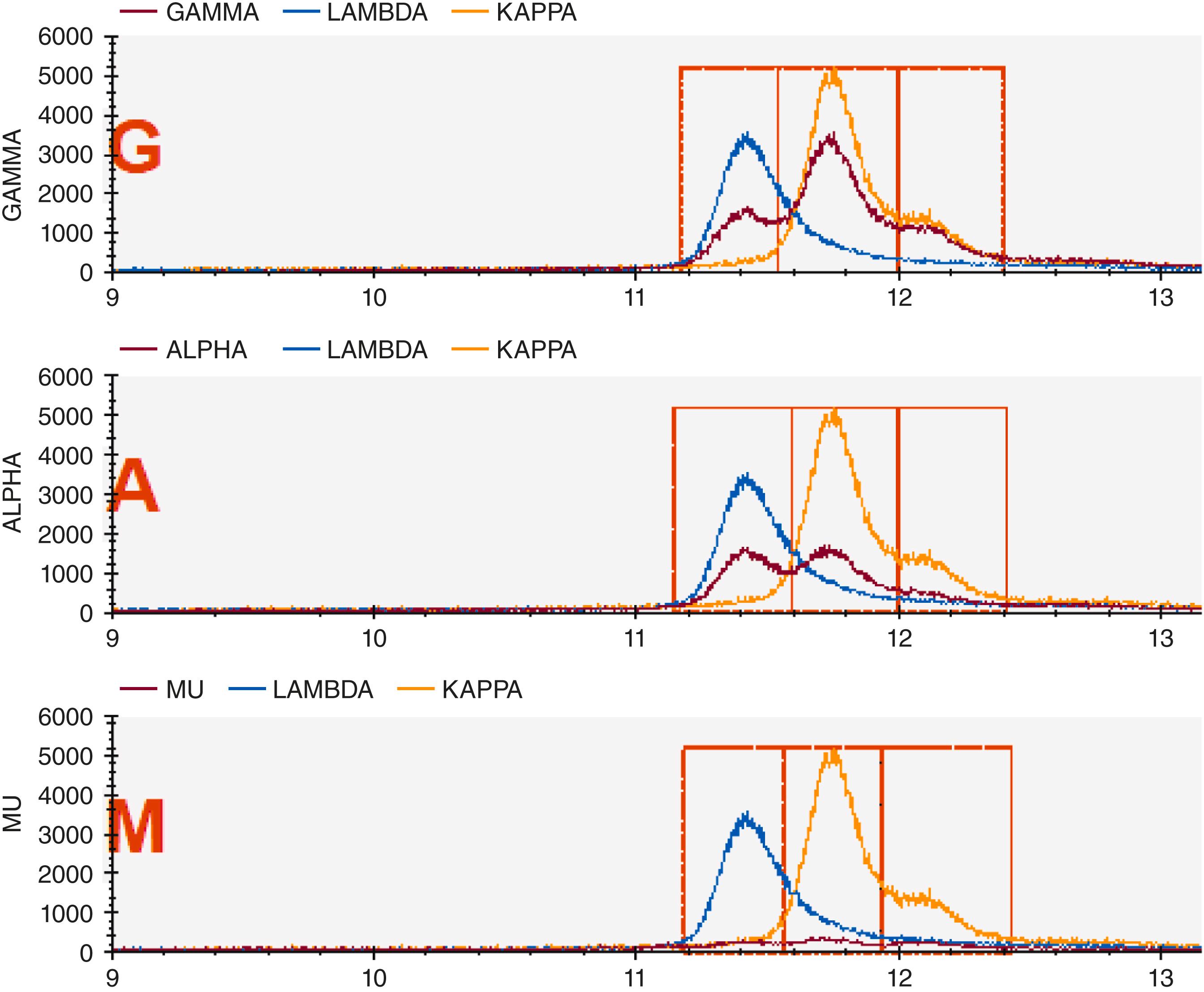
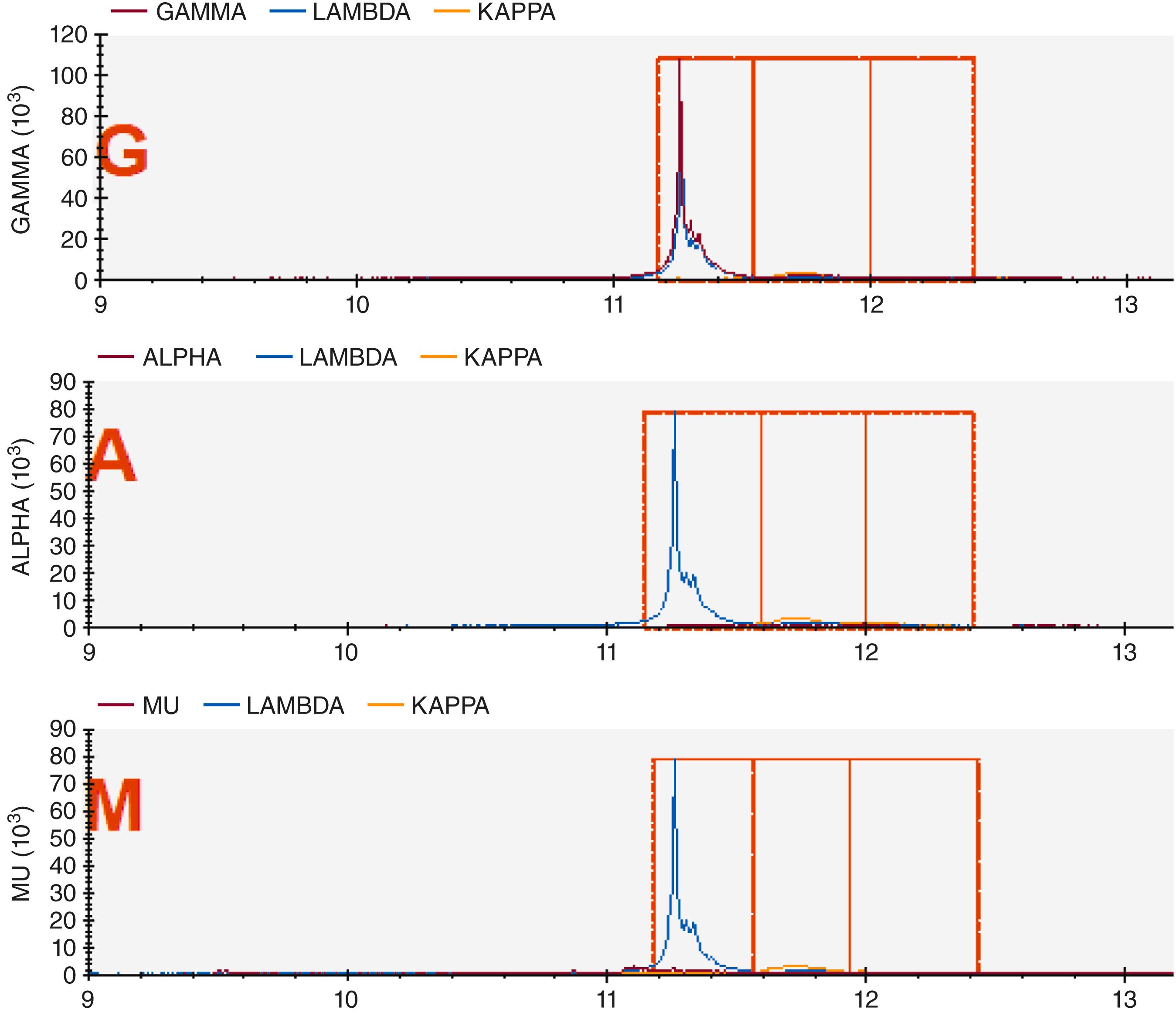
Monoclonal proteins must be distinguished from an excess of polyclonal immunoglobulins (one or more heavy chain types and both κ and λ light chains, usually limited to the γ region), which produce a broad-based peak or broad band ( Fig. 173-2 ). This finding is associated with chronic infectious or inflammatory states.
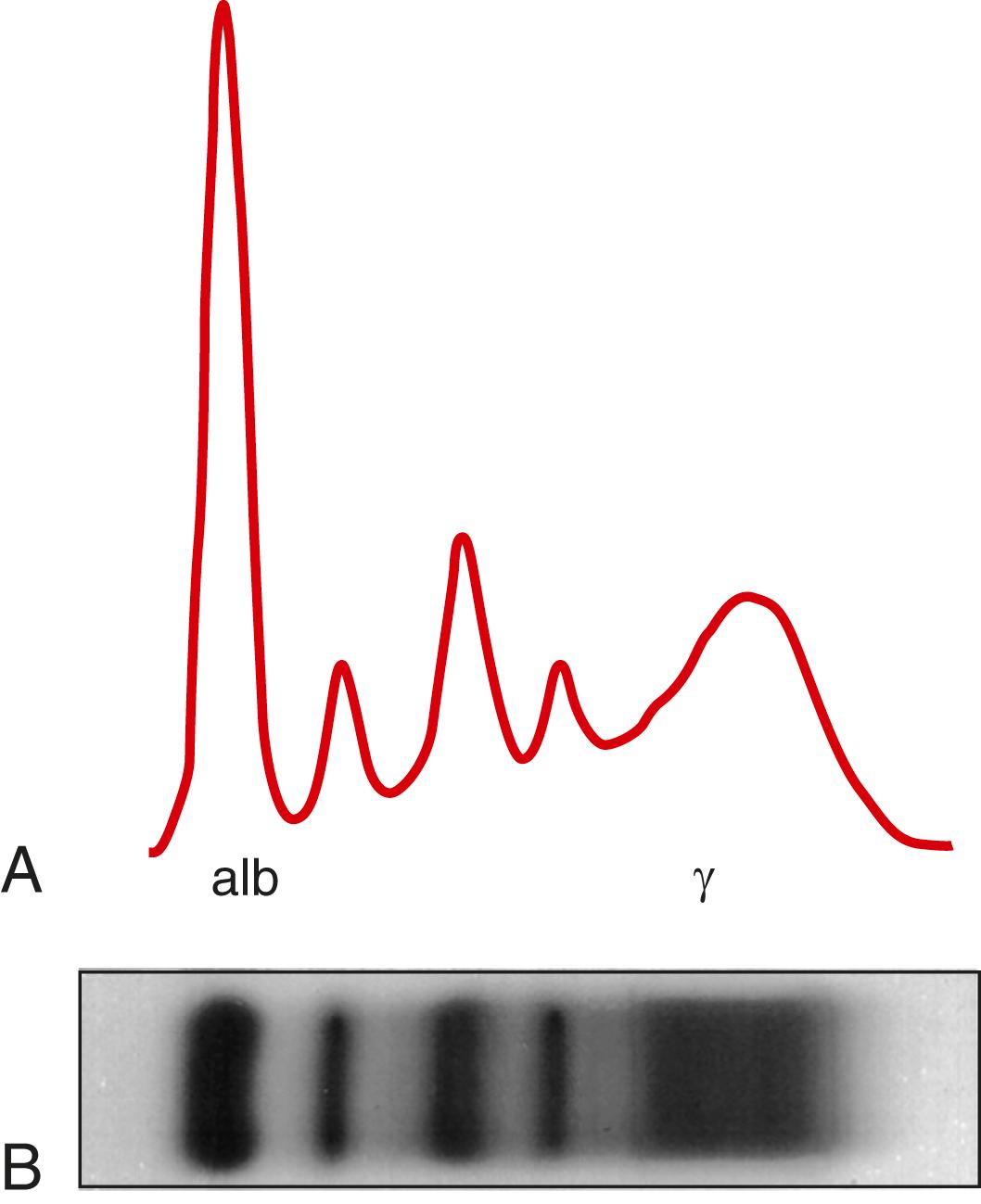
The serum free light chain assay measures the level of free κ and λ immunoglobulin light chains (i.e., light chains that are not bound to intact immunoglobulin). An abnormal κ/λ free light chain ratio (normal range, 0.26 to 1.65) indicates a significant excess of one light chain type versus the other and is interpreted as representing a monoclonal elevation of the corresponding light chain type. The serum free light chain assay is more sensitive than electrophoresis or immunofixation in detecting free monoclonal light chains and is useful in the diagnostic evaluation of plasma cell disorders and in risk stratification.
Monoclonal gammopathy of undetermined significance (MGUS; formerly called benign monoclonal gammopathy ) is a premalignant clonal plasma cell disorder characterized by the presence of a serum M protein in persons who lack evidence of multiple myeloma, macroglobulinemia, amyloidosis, or other related diseases. MGUS is defined by a serum M protein concentration lower than 3 g/dL, less than 10% clonal plasma cells in the bone marrow, and absence of myeloma-defining events. The main clinical significance of MGUS is its lifelong risk of transformation to myeloma or related malignancy at a fixed but unrelenting rate of 1% per year. There are three major types of MGUS: IgM MGUS, non-IgM MGUS, and light chain MGUS ( Table 173-2 ).
| DISORDER | DISEASE DEFINITION |
|---|---|
| IgM monoclonal gammopathy of undetermined significance (IgM MGUS) | All three criteria must be met:
|
| Non-IgM monoclonal gammopathy of undetermined significance (MGUS) | All three criteria must be met:
|
| Light chain MGUS | All criteria must be met:
|
| Smoldering multiple myeloma | Both criteria must be met:
|
| Multiple myeloma | Both criteria must be met:
|
| Solitary plasmacytoma | All four criteria must be met:
|
| Solitary plasmacytoma with minimal marrow involvement † | All four criteria must be met:
|
∗ A bone marrow can be deferred in patients with low-risk MGUS (IgG type, M protein <1.5 g/dL, normal free light chain ratio) in whom there are no clinical features concerning for myeloma.
† Solitary plasmacytoma with 10% or more clonal plasma cells is considered multiple myeloma.
Most patients in whom a serum M protein is detected have MGUS ( E-Fig. 173-3 ). The prevalence of MGUS in the general population increases with age, from approximately 1% in persons 50 to 60 years old to greater than 5% in those older than 70 years. The age-adjusted prevalence is higher in males than in females and is twice as high in Blacks compared with Whites ( E-Table 173-1 ). The prevalence of MGUS and of multiple myeloma is increased among blood relatives of individuals with monoclonal gammopathies.
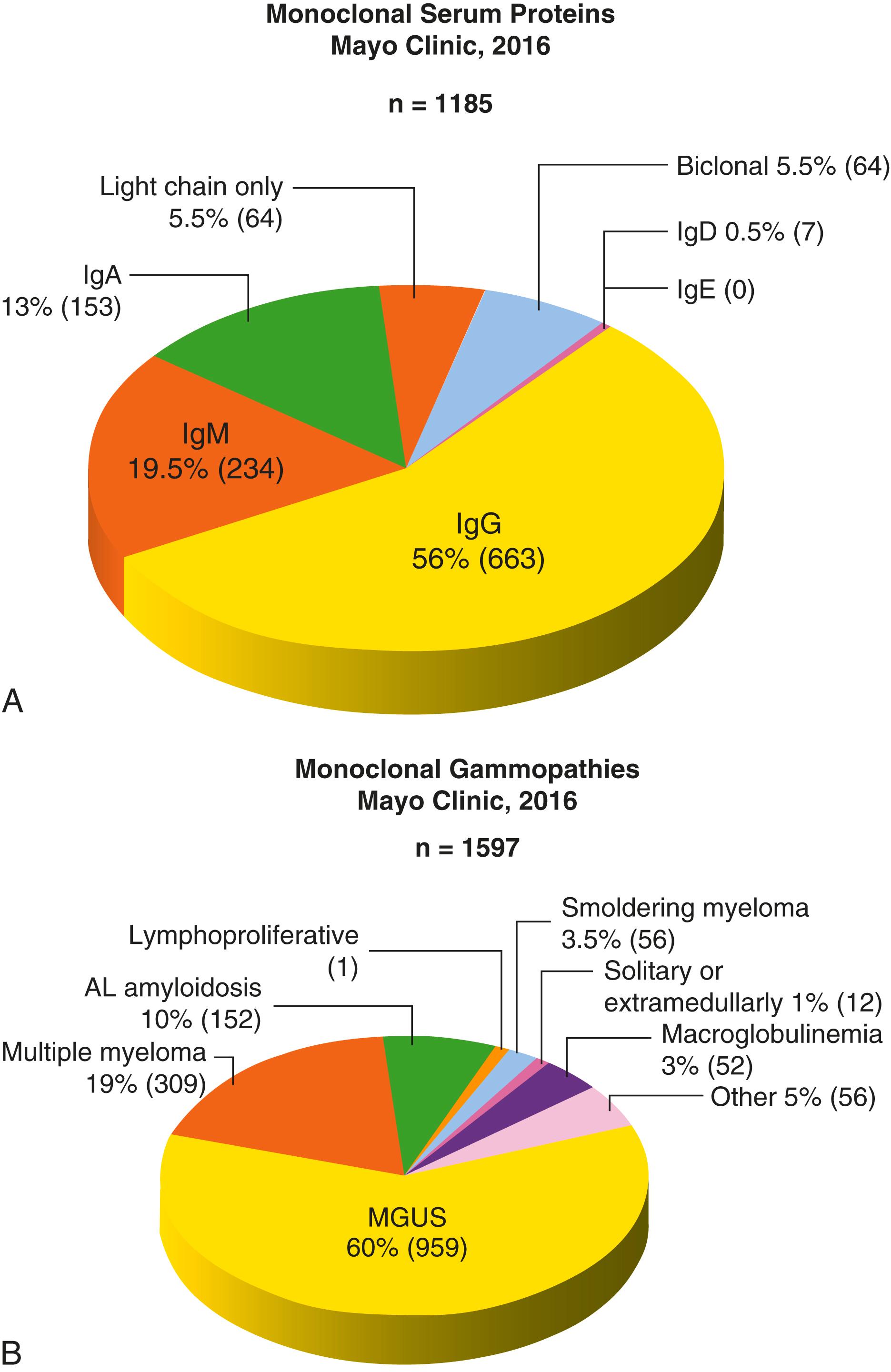
The etiology of MGUS is unknown, but age, male gender, family history, immunosuppression, and exposure to certain pesticides are known risk factors. It is hypothesized that infection, inflammation, or other antigenic stimuli, acting in concert with the development of cytogenetic abnormalities in the plasma cells, are the initiating pathogenetic events in most patients. Approximately 40% of MGUS is associated with plasma cell translocations involving the immunoglobulin heavy chain (IgH) locus on chromosome 14q32 (IgH translocated MGUS), 40% with trisomies involving odd-numbered chromosomes (hyperdiploid MGUS), 15% with both trisomies and IgH translocations, and the remaining with other cytogenetic abnormalities. The primary IgH translocations seen in MGUS commonly involve one of five recurrent partner chromosome loci: 11q13 ( CCND1 [cyclin D1 gene]), 4p16.3 ( FGFR-3 and MMSET ), 6p21 ( CCND3 [cyclin D3 gene]), 16q23 ( c-maf ), and 20q11 ( mafB ). On flow cytometry, normal plasma cells are preserved and reside alongside the clonal cells.
MGUS is asymptomatic and is usually diagnosed incidentally on laboratory testing. Patients with MGUS progress to multiple myeloma or related malignancy at a rate of approximately 1% per year. Patients with IgM MGUS are at risk of progression to Waldenström macroglobulinemia, while patients with non-IgM MGUS and light chain MGUS are at risk of progression to multiple myeloma. All forms of MGUS carry a risk of progression to AL amyloidosis.
| AGE GROUP (YEARS) | BLACKS % (95% CI) |
WHITES % (95% CI) |
HISPANIC AMERICANS % (95% CI) |
TOTAL POPULATION % (95% CI) |
|---|---|---|---|---|
| 10-19 | 0.00 (NA) | 0.0 (NA) | 0.1 (0.0-0.8) | 0.0 (0.0-0.1) |
| 20-29 | 0.3 (0.1-0.8) | 0.0 (NA) | 0.00 (NA) | 0.0 (0.0-0.1) |
| 30-39 | 0.9 (0.4-1.5) | 0.3 (0.1-1.0) | 0.2 (0.1-0.8) | 0.5 (0.3-0.9) |
| 40-49 | 3.3 (2.0-5.2) | 0.5 (0.2-1.4) | 2.2 (1.2-4.0) | 0.9 (0.5-1.5) |
| 50-59 | 2.2(1.3-3.6) | 1.0 (0.6-1.7) | 0.9 (0.3-2.2) | 1.2 (0.8-1.7) |
| 60-69 | 3.5 (2.3-5.3) | 2.4 (1.7-3.4) | 2.4 (1.7-3.4) | 2.5 (1.9-3.2) |
| 70-79 | 5.7 (3.7-8.7) | 3.4 (2.6-4.6) | 2.5 (1.4-4.6) | 3.4 (2.6-4.5) |
| 80+ | 8.6 (4.9-14.5) | 4.4 (3.3-5.9) | 4.0 (1.3-11.2) | 4.6 (3.5-5.9) |
MGUS represents a limited, nonmalignant expansion of monoclonal plasma cells. MGUS is differentiated from multiple myeloma and smoldering multiple myeloma by the level of the M protein, the percentage of plasma cells in the bone marrow, and the presence or absence of anemia, renal failure, hypercalcemia, or lytic bone lesions ( Table 173-2 ). Because anemia and renal insufficiency are relatively common in the elderly population with MGUS, the causes of these conditions should be carefully investigated with adequate laboratory studies. Only patients with strong evidence of end-organ damage thought to be directly related to a plasma cell disorder can be considered to have myeloma or a related malignancy.
Although a reduction in the levels of the immunoglobulin classes other than M protein (i.e., the normal polyclonal or background immunoglobulins) is more frequently seen in multiple myeloma or Waldenström macroglobulinemia, such reductions also occur in almost 40% of patients with MGUS.
MGUS is associated with numerous diseases. However, because 3% of the general population older than 50 years has MGUS, it is often difficult to determine whether these reported associations are causal or coincidental. Associations that have been verified based on epidemiologic studies include peripheral neuropathy ( Chapter 388 ), proliferative glomerulonephritis, deep vein thrombosis ( Chapter 68 ), osteoporosis ( Chapter 225 ), and lymphoproliferative disorders ( Chapter 171 ). A secondary form of MGUS also occurs with immunosuppression after organ transplantation ( Chapter 38 ) and autologous or allogeneic stem cell transplantation ( Chapter 163 ). M proteins also occur in the sera of some patients with CLL ( Chapter 169 ) but have no recognizable effect on the clinical course.
Approximately 5% of patients with sensorimotor peripheral neuropathy of unknown cause ( Chapter 388 ) have an associated monoclonal gammopathy (monoclonal gammopathy–associated peripheral neuropathy). Patients with IgM MGUS–associated peripheral neuropathy have a slowly progressive distal acquired demyelinating symmetric (DADS) presentation, with predominantly sensory symptoms beginning in the distal ends of the extremities and extending proximally. In contrast, non-IgM MGUS neuropathy may present similar to chronic inflammatory demyelinating polyneuropathy (CIDP) with both proximal and distal involvement and with more motor symptoms. A causal relationship between MGUS and peripheral neuropathy is usually assumed in younger patients and those without other conditions known to cause neuropathy in whom the neuropathy is severe and progressive. Therapeutic approaches include intravenous immunoglobulin or rituximab for IgM monoclonal proteins and plasmapheresis or prednisone for non-IgM monoclonal proteins.
Monoclonal gammopathy is also felt to be the underlying cause of approximately 50% of idiopathic proliferative glomerulonephritis ( Chapter 107 ), including membranoproliferative glomerulonephritis and C3 glomerulopathy. Certain skin disorders are also known to be associated with MGUS. Lichen myxedematosus (papular mucinosis, scleromyxedema) ( Chapter 407 ) is associated with an IgG γ protein. Pyoderma gangrenosum and necrobiotic xanthogranuloma are other associated skin disorders.
No treatment is necessary for MGUS ( Fig. 173-3 ). A baseline bone marrow biopsy and bone imaging can be omitted in patients who appear clinically to have low-risk, uncomplicated MGUS, small IgM MGUS, or light chain MGUS with a free light chain ratio less than 8. Bone imaging can also be omitted in patients who have IgM MGUS and in whom bone disease is not suspected. Low-risk patients ( Table 173-3 ) should be evaluated in 6 months and, if stable, require no further follow-up until symptoms suggestive of myeloma or related disorders occur. In all other patients with MGUS, electrophoresis, serum free light chains, complete blood count, and creatinine and calcium levels should be repeated at 6 months and, if stable, yearly thereafter.
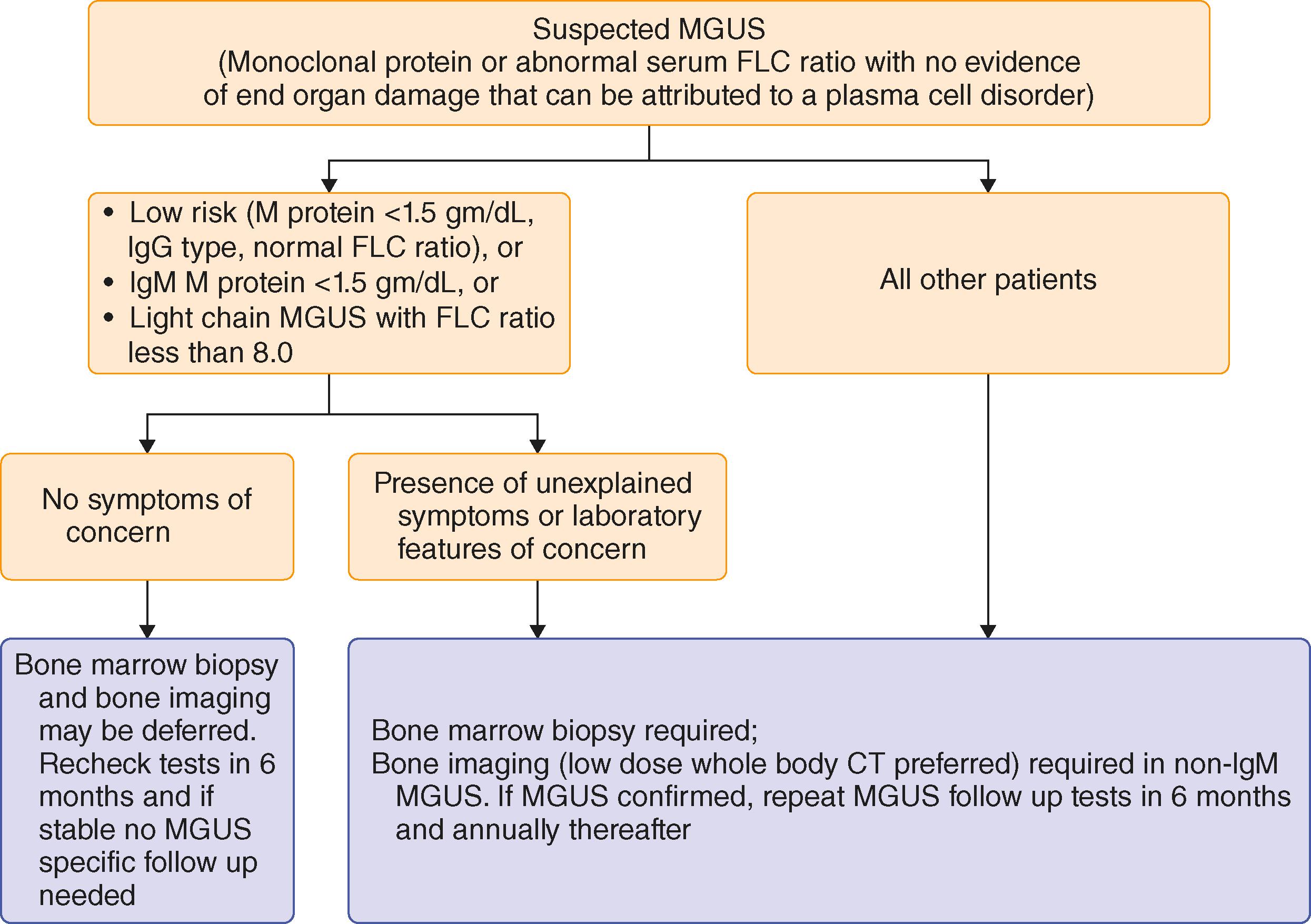
| RISK GROUP | RELATIVE RISK | CUMULATIVE ABSOLUTE RISK OF PROGRESSION AT 20 YR (%) ∗ | CUMULATIVE ABSOLUTE RISK OF PROGRESSION AT 20 YR ACCOUNTING FOR DEATH AS A COMPETING RISK (%) † |
|---|---|---|---|
| Low risk: serum M protein <1.5 g/dL, IgG subtype, normal free light chain ratio (0.26-1.65) | 1 | 5 | 2 |
| Low-intermediate risk: any one factor abnormal | 5.4 | 21 | 10 |
| High-intermediate risk: any two factors abnormal | 10.1 | 37 | 18 |
| High risk: all three factors abnormal | 20.8 | 58 | 27 |
∗ Estimates in this column represent the risk of progression, assuming that patients do not die of other causes during this period.
† Estimates in this column represent the risk of progression calculated by using a model that accounts for the fact that patients can die of unrelated causes during this time.
Differentiating a patient with MGUS in whom the disorder will remain stable for life from one in whom multiple myeloma, macroglobulinemia, or a related disorder will eventually develop is difficult when the M protein is first recognized. The size and type of the M protein at diagnosis of MGUS and an abnormal serum free light chain ratio are prognostic factors for progression (see Table 173-3 ). Overall, about one third of patients progress to a symptomatic monoclonal gammopathy over 10 or more years.
Biclonal gammopathies occur in at least 5% of patients with clonal plasma cell disorders. A biclonal gammopathy of undetermined significance (analogous to MGUS) accounts for about two thirds of such patients. The remainder have multiple myeloma, macroglobulinemia, or other lymphoproliferative diseases. Rarely, triclonal gammopathies may occur.
Multiple myeloma is a malignancy of plasma cells characterized by bone marrow infiltration and extensive skeletal destruction resulting in anemia, bone pain, and fractures. Multiple myeloma (commonly referred to as myeloma ) is defined by the presence of 10% or more clonal plasma cells on bone marrow examination, M protein in serum or urine (except in the case of nonsecretory myeloma), and evidence of one or more myeloma-defining events (see Table 173-2 ). Patients with multiple myeloma must be differentiated from those with MGUS and smoldering multiple myeloma.
Multiple myeloma accounts for 1% of all malignant disease and slightly more than 10% of hematologic malignancies in the United States. The annual incidence of multiple myeloma is approximately 4 per 100,000. The incidence of multiple myeloma in Blacks is almost twice that in Whites. Multiple myeloma is slightly more common in men than in women. The median age of patients at the time of diagnosis is about 65 years; only 2% of patients are younger than 40. In a population screening study in Iceland, the prevalence of smoldering multiple myeloma (defined as an M protein spike ≥3 g/dL and/or 10 to 60% bone marrow plasma cells) was 0.5% in individuals ages 40 years and older.
The cause of multiple myeloma is unclear. Exposure to radiation, benzene, and other organic solvents, herbicides, and insecticides may play a role. Multiple myeloma has been reported in familial clusters of two or more first-degree relatives and in identical twins.
Almost all cases of myeloma evolve from a premalignant MGUS phase, although the MGUS is clinically recognized before the diagnosis of myeloma in only a small minority of patients. The progression of MGUS to myeloma suggests a simple, random, two-hit genetic model of malignancy in which the risk of progression is fixed (approximately 1% per year) regardless of the duration of MGUS. Unfortunately, the precise mechanisms of progression are unknown, although several potentially pathogenetic abnormalities have been described in the clonal plasma cells. The two main events associated with progression of MGUS to multiple myeloma appear to be RAS mutations and MYC abnormalities. Deletions involving 17p and 1p and amplification of 1q occur with disease progression in multiple myeloma and are associated with adverse prognosis. These changes cause dysregulation of the NF-κB and other signaling pathways. Normal plasma cell differentiation is also affected. Changes in the bone marrow microenvironment likely play a major role in the pathogenesis, including induction of angiogenesis and abnormal paracrine loops involving cytokines such as interleukin-6 (IL-6), which serves as a major growth factor for plasma cells.
The lytic bone lesions, osteopenia, hypercalcemia, and pathologic fractures in patients with myeloma are a result of abnormal osteoclast activity induced by the neoplastic plasma cells, as well as inhibition of osteoblast differentiation. Osteoclasts are activated by stimulation of the transmembrane receptor RANK (receptor activator of nuclear factor κB), which belongs to the tumor necrosis factor (TNF) receptor superfamily. The ligand for this receptor (RANKL) also has a decoy receptor, osteoprotegerin (OPG). In myeloma, there is an increase in RANKL expression by osteoblasts (and possibly plasma cells), accompanied by a reduction in the level of OPG. The resultant increase in the RANKL/OPG ratio causes osteoclast activation and increased bone resorption and turnover ( Chapter 225 ). Other factors that may play a role in osteoclast activation include increased levels of macrophage inflammatory protein–1-alpha (MIP-1-alpha), stromal derived factor alpha (SDF-alpha), IL (interleukin)-3, IL-1 beta, and IL-6. In addition to these changes that promote osteoclast activation, simultaneous suppression of osteoblasts is mediated by increased levels of IL-3, IL-7, and dickkopf 1 (DKK1). This combination leads to the pure osteolytic bone disease that is the hallmark of multiple myeloma.
As discussed earlier (see Pathobiology of MGUS), primary translocations involving the IgH loci (chromosome 14q32) are seen in up to 40% of patients with multiple myeloma (IgH-translocated or nonhyperdiploid myeloma). Approximately 40% of patients do not have IgH translocations but have evidence of trisomies (hyperdiploid myeloma), 15% have both IgH translocations and trisomies, and 5% have other abnormalities. Although IgH translocations and trisomies originate at the MGUS stage, the response to therapy and prognosis of myeloma are affected by the specific underlying abnormality ( Table 173-4 ). Besides these primary cytogenetic abnormalities, other abnormalities (termed secondary cytogenetic abnormalities) occur as late events during the course of symptomatic myeloma; these include deletion of 17p, deletion of 1p, and amplification of 1q.
| STAGE/RISK FACTOR |
|---|
| Stage I (serum albumin >3.5, serum beta-2-microglobulin <3.5, no high-risk cytogenetics, and normal serum lactate dehydrogenase level) |
| Stage II (neither stage I nor stage III) |
| Stage III (serum beta-2-microglobulin >5.5 and either high-risk cytogenetics [t(4;14), t(14;16), or del(17p)] or elevated serum lactate dehydrogenase level) |
High-risk myeloma (any one of the following):
|
Standard-risk myeloma
|
| Poor performance status |
| Increased circulating plasma cells |
| Plasmablastic morphology |
Many patients are asymptomatic because they are detected early based on incidental laboratory testing. Smoldering (asymptomatic) multiple myeloma is defined by the presence of an M protein level greater than 3 g/dL in serum or 10 to 60% clonal plasma cells in bone marrow in the absence of anemia, renal insufficiency, hypercalcemia, or skeletal lesions. Clinically, patients with smoldering multiple myeloma are similar to patients who have MGUS but carry a much higher risk for progression to myeloma or a related malignancy: 10% per year for the first 5 years, 5% per year for the next 5 years, and 1 to 2% per year thereafter. Even patients who meet the full criteria for multiple myeloma may be asymptomatic and be detected only by an evaluation of laboratory abnormalities.
Bone pain, particularly in the back or chest and less often in the extremities, is present at the time of diagnosis in more than two thirds of patients. The patient’s height may be reduced by several inches because of vertebral collapse. Weakness and fatigue are common and are often associated with anemia. The incidence of infections is increased in patients with multiple myeloma. The propensity for infection results from impairment of the antibody response, deficiency of normal immunoglobulins, and neutropenia. Myeloma patients also have an increased risk of deep vein thrombosis, although some myeloma treatments (e.g., lenalidomide) may themselves cause thrombosis. Other symptoms may result from renal insufficiency, hypercalcemia, nephrotic syndrome, radiculopathy, or AL amyloidosis ( Chapter 174 ).
Pallor is the most frequent physical finding in patients with multiple myeloma. The liver is palpable in about 5% of patients and the spleen in only 1%. Tenderness may be noted at sites of bone involvement. Radiculopathy may be caused by spinal compression fractures. Occasionally, extramedullary plasmacytomas are palpable.
Become a Clinical Tree membership for Full access and enjoy Unlimited articles
If you are a member. Log in here